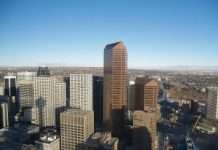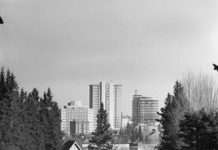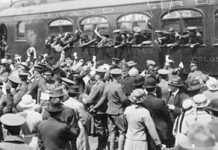!["Houses in Mount Royal district on Royal Avenue, Calgary, Alberta.", [ca. 1912], (CU1218716) by Unknown. Courtesy of Glenbow Library and Archives Collection, Libraries and Cultural Resources Digital Collections, University of Calgary. https://digitalcollections.ucalgary.ca/asset-management/2R3BF1OMH243.](https://mycalgary.com/wp-content/uploads/2025/05/7.jpg)
by Anthony Imbrogno, a volunteer with The Calgary Heritage Initiative Society/Heritage Inspires YYC
Calgary’s first boom saw the population grow 10x during 1901 to 1911.
Inglewood developed a commercial street, including mixed-use blocks, Fire Hall No. 3, and National Hotel. The Calgary Brewery expanded, producing 450 barrels/day.
The Beltline became a bustling neighbourhood. There was Club Carousel, which housed Calgary’s first coffeehouse, first gay club, and a venue for Joni Mitchell. Pryce-Jones Department Store opened in 1910 followed by manufacturing buildings, like Biscuit Block.
After work, the King Eddy and St. Louis hotels were staples of Calgary’s social scene. If you fell ill, Calgary’s second general hospital opened in 1895, and the third opened in Bridgeland in 1910. Bridgeland-Riverside is located along the Old North Trail to Edmonton, with the DeWaal Block housing working class immigrants.
Alberta’s first library, Memorial Park, was built in 1912. Westwards, Nimmons ranch house became Calgary’s first to use brick, supplied by Brickburn (today’s Edworthy Park).
The surrounding towns grew too. A railway siding called Airdrie became today’s bedroom community. Canmore was a coal mining town in 1884. Bragg Creek was homesteaded in 1894 and hosted North America’s first hostel. Okotoks is on the Calgary-to-Fort Macleod trail, with the US-bound railway arriving in 1892. Due east is Chestermere, a wetland turned lakeside community thanks to an irrigation canal, and Strathmore, a hamlet for workers and farmers.
Calgary also grew by annexation. Mount Royal was known as American Hill since Americans first built mansions along Royal Avenue. Ramsay was/is an industrial, commercial, and residential neighbourhood. Sunnyside was home for CPR and Eau Claire sawmill workers, while Hillhurst/Hounsfield became “Mount Royal of the North”. Meanwhile, Calgary’s third Chinatown was founded by Chinese owners.
Calgary’s diversifying economy meant the cowboy life was fading away. Guy Weadick thought Calgary was perfect for an agricultural festival. The Big Four ranchers thought it could be one last sunset ride for Cow Town. Weadick invited Indigenous peoples to the first Stampede, held in 1912. It was a smashing success.
Another success in 1919 proved Weadick’s point, and the annual Stampede tradition began in 1923. The city continues to embrace its roots every July, rightfully becoming Stampede City. Yahoo!
All copyright images cannot be shared without prior permission.

“No. 1 mine, Canmore, Alberta.”, [ca. 1913-1919], (CU1115985) by Carroll, Daisy. Courtesy of Glenbow Library and Archives Collection, Libraries and Cultural Resources Digital Collections, University of Calgary. https://digitalcollections.ucalgary.ca/asset-management/2R3BF1OT651G?WS=SearchResults.

“First youth hostel in North America, Bragg Creek, Alberta.”, 1933, (CU1128685) by Unknown. Courtesy of Glenbow Library and Archives Collection, Libraries and Cultural Resources Digital Collections, University of Calgary. https://digitalcollections.ucalgary.ca/asset-management/2R3BF1O45YT2?WS=SearchResults.

“Atlantic (9th) Avenue, Calgary, Alberta, looking west.”, [ca. 1885], (CU176817) by Bingham, F. V.. Courtesy of Glenbow Library and Archives Collection, Libraries and Cultural Resources Digital Collections, University of Calgary. https://digitalcollections.ucalgary.ca/asset-management/2R3BF14A3B26.

“Calgary General Hospital, Calgary, Alberta.”, [ca. 1905], (CU11056806) by Unknown. Courtesy of Glenbow Library and Archives Collection, Libraries and Cultural Resources Digital Collections, University of Calgary. https://digitalcollections.ucalgary.ca/asset-management/2R3BF1OWWBBI?WS=SearchResults.

“Central Park [Memorial Park], Calgary, Alberta.”, 1913, (CU183489) by Reader W. R.. Courtesy of Glenbow Library and Archives Collection, Libraries and Cultural Resources Digital Collections, University of Calgary. https://digitalcollections.ucalgary.ca/asset-management/2R3BF1F9LZI5?WS=SearchResults.

“View looking east from Calgary Pressed Brick and Sandstone Company plant, Brickburn, Alberta.”, [ca. 1920-1931], (CU1136204) by Unknown. Courtesy of Glenbow Library and Archives Collection, Libraries and Cultural Resources Digital Collections, University of Calgary. https://digitalcollections.ucalgary.ca/asset-management/2R3BF1XGYURN?WS=SearchResults.

“Houses in Mount Royal district on Royal Avenue, Calgary, Alberta.”, [ca. 1912], (CU1218716) by Unknown. Courtesy of Glenbow Library and Archives Collection, Libraries and Cultural Resources Digital Collections, University of Calgary. https://digitalcollections.ucalgary.ca/asset-management/2R3BF1OMH243.

“Eau Claire and Bow River Lumber Company office, Calgary, Alberta.”, [ca. 1904], (CU181923) by Unknown. Courtesy of Glenbow Library and Archives Collection, Libraries and Cultural Resources Digital Collections, University of Calgary. https://digitalcollections.ucalgary.ca/asset-management/2R3BF1OMXWST?WS=SearchResults.

“Decorated tipis, Calgary Exhibition and Stampede, Calgary, Alberta.”, 1912-09, (CU182251) by Unknown. Courtesy of Glenbow Library and Archives Collection, Libraries and Cultural Resources Digital Collections, University of Calgary. https://digitalcollections.ucalgary.ca/asset-management/2R3BF1OV9V9V.

“First Nations people at Victory Stampede, Calgary, Alberta.”, 1919, (CU1106253) by Unknown. Courtesy of Glenbow Library and Archives Collection, Libraries and Cultural Resources Digital Collections, University of Calgary.









